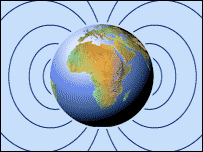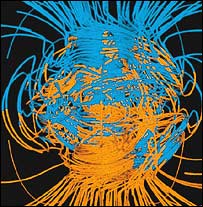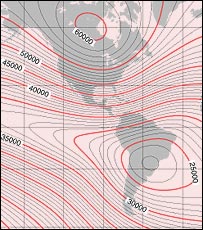|
|
 |
|
Scientists have known for some time that the Earth's magnetic field is fading.
Like a Kryptonite-challenged Superman, its strength has steadily and mysteriously waned, leaving parts of the planet vulnerable to increased radiation from space. Some satellites already feel the effects. What is uncertain is whether the weakened field is on the way to a complete collapse and a reversal that would flip the North and South Poles. Compasses pointing North would then point South. It is not a matter of whether it will happen, but when, said scientists who presented the latest research on the subject at a recent meeting of the American Geophysical Union in San Francisco. But when is hard to pinpoint. The dipole reversal pattern is erratic. "We can have periods without reversals for many millions of years, and we can have four or five reversals within one million years," said Yves Gallet, from Institut de Physique du Globe de Paris, France, who studies the palaeomagnetic record and estimates that the current decay started 2,000 years ago. (This is not surprising due to the current energy cycle starting 2,000 years ago) See harmonics research for more on this! Flip or flop Over the last century and a half, since monitoring began, scientists have measured a 10% decline in the dipole. At the current rate of decline it would take 1,500 to 2,000 years to disappear. SEAFLOOR RECORDER A particular weakness in the field has been observed off the coast of Brazil in the so-called Southern Atlantic Anomaly. Here, eccentricities in the Earth's core have caused a "dip" in the field, leaving it 30% weaker than elsewhere. The extra dose of radiation creates electronic glitches in satellites and spacecraft that fly through it. Even the Hubble telescope has been affected. Magnetic reversals were always preceded by weakened magnetic fields, said Dr Gallet, but not all weakened fields bring on a flip-flop. The Earth's invisible shield could also grow back in strength. "Then sometime, maybe 10,000 years from now, the dipole will decay again and that will lead to a reversal," said Harvard physicist Jeremy Bloxham. The theme was recently taken up by Hollywood in the movie The Core, in which the Earth's core mysteriously stops spinning, effectively turning off the electromagnetic field. The movie is nonsense, scientists told BBC News Online, except that the Earth's magnetic field is generated by activity deep inside it. Iron record The heat of the solid inner core keeps the molten cocktail of nickel and iron churning in the outer core, which generates a magnetic field. It is not known how the core behaves exactly, but scientists have a general understanding of how electrical and fluid currents and magnetic field lines all interact to produce the field we experience outside Earth. " If we had the equivalent of a space probe that went into the core and made measurements for us, that would tell us a tremendous amount " Imagine the magnetic field lines within the core "twisting like spaghetti," said Peter L Olson, geophysics professor at Johns Hopkins University. As they wind and kink around each other, their interaction can accentuate the magnetic field or diminish it. "Depending on how it's kinked," he said, "it can be helpful or harmful." The last time the field lines kinked into a dipole reversal was 780,000 years ago. By studying sea floor sediment and lava flows, scientists can reconstruct the magnetic field patterns of the past. Iron in lava, for example, points in the direction of the then-existing field and is frozen in that orientation as the lava cools and hardens. (Most of this data is only the after effect of an anomaly that is far more extensive and complex. Outer energy fields play on our own magnetic fields and this kinking effect that is displayed in lava content is the result of that.) According to Dr Gallet, the oldest reversal that has been studied by lava flows comes from Greenland, dated at 16 million years. The time between reversals varies from a thousand to millions of years. Global light show So is the Earth about to flip? The safe bet may disappoint screenplay writers everywhere. "Chances are we're not," said Dr Bloxham. "Reversals are rare events." And they would certainly not threaten life on Earth as they do in science fiction. Although there would be extra radiation exposure to satellites and some airplanes, there would also be enough of a residual field to provide protection to people, and certainly no more radiation than what is observed at the poles, where the field lines currently dip.
But there would be some bizarre readjustment. Prior to Earth's poles reestablishing themselves, a period of disorder would produce multiple poles, according to Dr Bloxham, which may make backwoods camping tricky. "Getting around using a magnetic compass would be a more complicated endeavor," he said. A collapse would also produce a great increase in auroral activity - the beautiful display of lights generated by solar particles that follow the magnetic field lines down into the atmosphere. And there would be plenty of time to grab a camera - the reversal is gradual. This would give animals which use the magnetic field for navigation, such as some birds, turtles and bees, time to reorient themselves. "They'd go through many generations in the period in which the field was entering the phase of reversal," said Dr Bloxham. "Presumably they would learn new behavior patterns to accommodate it." Space within As for the ozone layer - which was thought to be vulnerable without a protective shield - the effects would be negligible unless there was a super-solar proton event, said Charles H Jackman, an atmospheric physicist at the US space agency's Goddard Flight Center, referring to the high-energy radiation that can accompany solar flares. The charged particles zinging down to Earth, said Dr Jackman, break apart molecules of nitrogen, whose atoms go on to form nitric oxide, which devours up ozone. This happens all the time, but the effects would be increased during a magnetic reversal or diminished magnetic field. (This also can occur in reduced magnetic flux as the radiation can penetrate a weaker field.) Bit like thinner paper lets more sunlight through it!
But he said scientists saw no significant change in ozone depletion due to the Southern Atlantic Anomaly. In any case, the ozone layer would bounce back quickly from the heavy solar bombardment, healing itself in just two to three years, according to Dr Jackman. (Geeze! Not if the ozone was being bombarded with pollutants that eliminate it!) This is not the timeline associated with anthropogenic chlorofluorocarbons. "Chlorofluorocarbons have a much longer lifetime in the atmosphere than does the nitric oxide and its associated constituents," he said. But all these scenarios are of an indeterminate future. The Earth's interior will remain unexplored for a long time to come - only in science fiction can humans or their equipment survive the 5,500 Celsius temperature in the core to study its activity. "If we had the equivalent of a space probe that went into the core and made measurements for us, that would tell us a tremendous amount," said Dr Bloxham. "Hollywood may be able to do these things, but we can't." (Want a bet!)
|
|
(c) Copyright 1993-2008 Publishing |
| [Home] [Main index] [Environment] [Magnetic field] |


